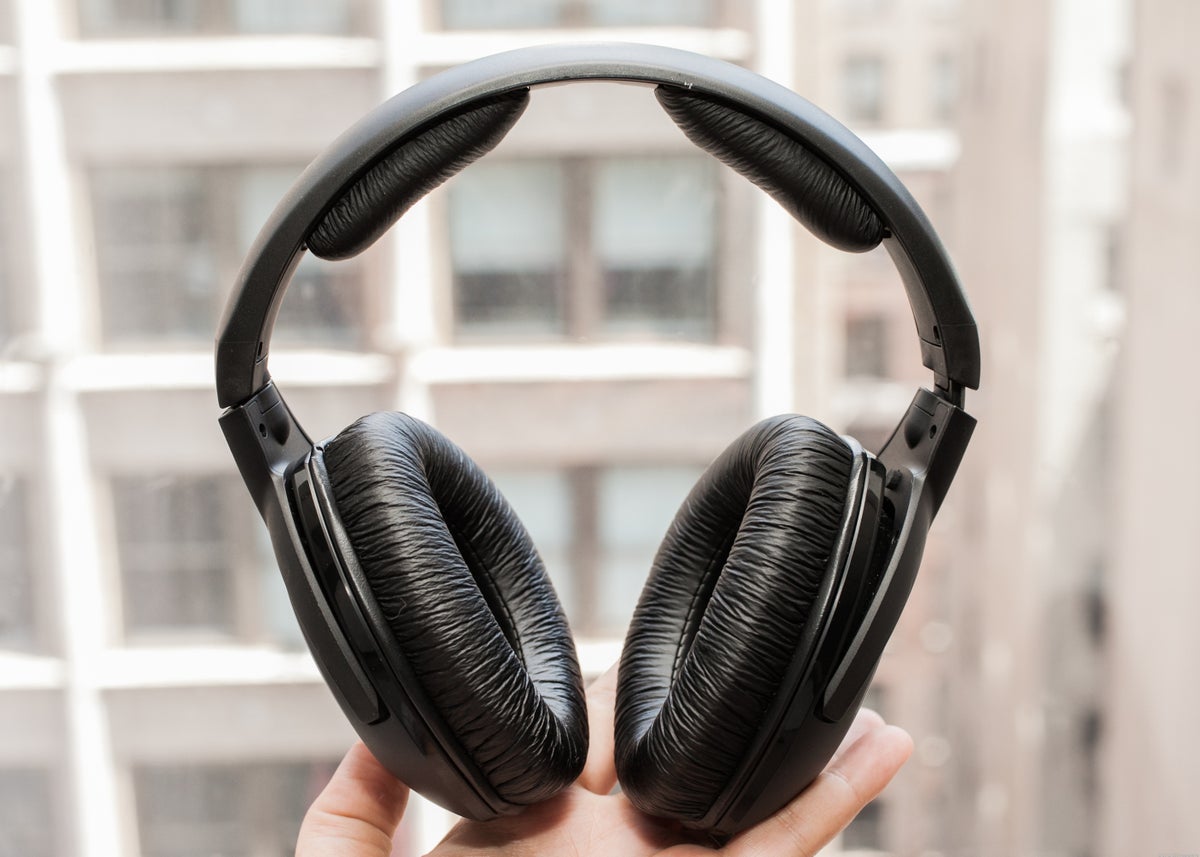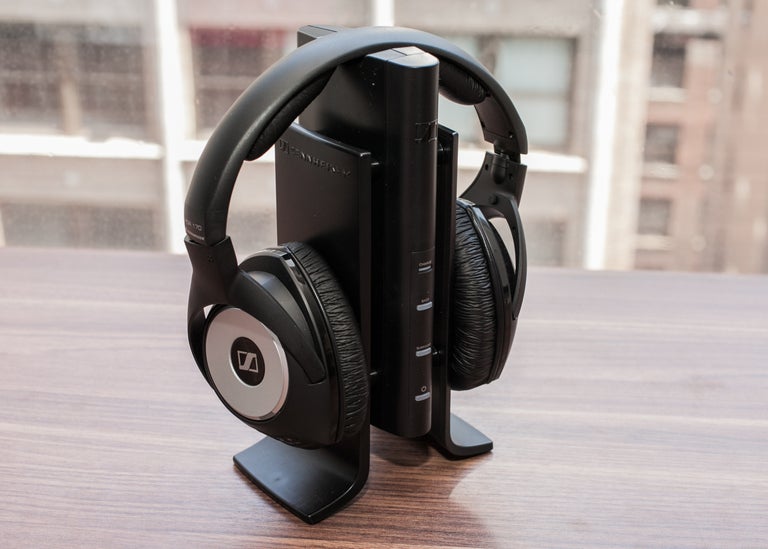 Why You Can Trust CNET
Why You Can Trust CNET Sennheiser RS 170 review: Sennheiser RS 170
The Sennheiser RS 170 wireless headphones are worth the price for anyone looking to grab wireless sound from a TV, AV receiver, cable box, or game console.
The $279.95 Sennheiser RS 170 is a set of wireless headphones with a base unit that doubles as a transmitter and a battery charger. One of the nicest things a reviewer can say about wireless headphones is that they don't sound like wireless headphones, and the RS 170 certainly succeeds on that score. Connectivity is limited to just one analog input, which might be a deal breaker for some potential buyers, but the idea is that you hook up the transmitter to your TV or AV receiver, and then run your sources, like your cable box, Blu-ray player, or games, etc., through the TV or receiver. If that's what you're looking to do, the RS 170 is definitely worthy of your consideration.
The Good
The Bad
The Bottom Line
Design and features
The RS 170 weighs just 216 grams without batteries thanks to its plastic construction. The satin black-and-silver headphones' build quality feels sturdy enough aside from where the earcups attach to the headband. There seems to be a bit of play in the joint that may cause problems with breakage over the long term.
The plush, padded headband and user-replaceable faux-leather earpads feel luxurious, and their oval shape conforms better to ears than the circular earpads used by competing headphone manufacturers.

The RS 170 is powered by a single NiMH (nickel-metal hydride) AAA battery in each earcup, and the company claims a fully charged set can deliver up to 24 hours of play time.
The black plastic transmitter/battery charger base also doubles as a headphone stand. Some buyers may feel slighted by the single 3.5mm analog input, but I actually don't consider it a limitation when the RS 170 is used with a TV or AV receiver. Those users can plug all their sources (cable box, game consoles, Blu-ray player, etc.) into their television or AV receiver and simply connect the RS 170 to the TV or receiver's stereo analog outputs.
If you absolutely insist on a digital connection, go for Sennheiser's $599 RS 220 wireless headphone model that has two digital inputs. Finally, the RS 170's power supply comes with four power receptacle adapters, one each for the U.S., U.K., Australia, and the EU.
The tightly clustered volume up/down, power, Surround Sound Simulator, and Dynamic Bass Boost button arrangement along the bottom of the right earcup isn't ergonomically ideal. For example, the power button is centered between the volume up/down buttons, so I accidently turned the power off when trying to adjust the volume a couple of times.
The Surround Sound Simulator and Dynamic Bass Boost buttons are smaller and even trickier to find when you're feeling around with your finger, so it may take some time before you can locate them without making mistakes. Sennheiser also gives access to the bass booster and surround features from the transmitter/charger base.
The RS 170 features 2.4-2.8 GHz Kleer carrier frequency wireless technology that offers lossless, CD-quality, 16-bit/44.1-kHz resolution. The system mostly worked flawlessly, but the sound occasionally cut out when I was across the room from the transmitter and seated in front of my computer. I experienced no other interruptions anywhere else in the room or my apartment.
Accessories include a 3.5mm-male-to-3.5mm-male analog cable, a female-3.5mm-to-stereo-male-RCA cable, and a 3.5mm-to-6.3mm adapter plug. Sennheiser also sells extra sets of RS 170 headphones without the transmitter/charger base; you can use up to four with one home transmitter base (for $119.95 each).
The RS 170 comes with a two-year warranty, and proof of purchase or sales receipt from an authorized dealer is required for warranty claims.
Performance
I didn't feel like I had to go easy on judging the RS 170s' sound quality because they're wireless headphones: they're very good-sounding, closed-back headphones, period. The RS 170's electronics don't add any background noise or hiss, but the sound occasionally cut out when I was across the room from the transmitter and seated in front of my computer. Sennheiser claims the headphones have a 260 foot "line-of sight" range, and the RS 170 even worked outside my apartment, about 20 feet from my front door.
Most stereo headphones with surround simulation modes tend to sound hollow or processed, but the RS 170 suffers no such problems. The Surround Sound Simulator feature spreads the stereo image wider than plain stereo, so it's less stuck inside my head. The Dynamic Bass Boost also works well, adding more fullness to the sound of the bass without overdoing it.
The RS 170 played fairly loud, actually a little louder than Sennheiser's top-of-the-line RS 220 wireless headphones with Eminem's "Live From New York City" DVD. Putting the maximum volume question aside, the RS 220 produced deeper bass and better sound overall. Most battery-powered headphones face the same loudness limitation compared with wired headphones, so if you want to play movies, games, or music really loud, I recommend buying a wired set of headphones instead.
As a closed-back-design model, the RS 170 sounds more "contained" and less expansive than Sennheiser's open-back Sennheiser RS 180 ($329.95). The RS 180 makes the traffic scenes in Fight Club's dingy city environment seem to come from off in the distance, while switching over to the RS 170 reduces the spaciousness and brings the sounds closer. Even so, the RS 170's sound quality is still very clear and easy to aurally digest over the course of a long movie. Switching between the two headphones, I did notice that the RS 180 has a richer sound balance and makes deeper and better-defined bass than the RS 170.
One significant advantage of the RS 170 is that its sound will only be heard by the person wearing the headphones. That makes it ideal to wear in bed -- where it won't disturb anyone nearby. Comparatively, the RS 180 and RS 220 will be audible to others.
Conclusion
Though the Sennheiser RS 170 is one of the least expensive wireless Sennheisers, I enthusiastically recommend it (even to persnickety audiophiles) for its wide stereo image projection and impressive maximum volume levels. It may not be the best-sounding set of wireless headphones from Sennheiser, but the RS 170 is very much worth the price for budget-minded shoppers.


